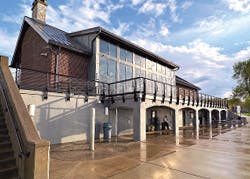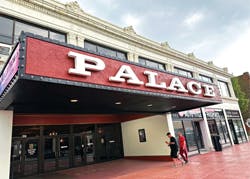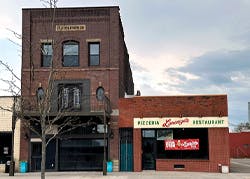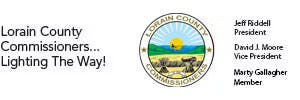THE PAST
Almost nothing in Downtown Lorain was left untouched after the tornado struck on June 24, 1924. After just five minutes, Broadway and nearby streets became almost unrecognizable. Grocery stores, churches and taverns became piles of rubble. Streets were impassable because of overturned cars and torn-off wooden plank siding. Dogs that were spared ran aimlessly sniffing for their owners. More than 500 houses were destroyed and a thousand more damaged.
The physical scars to downtown from the tornado may be not always apparent after 100 years, but they exist.
“Just about every building or location on Broadway has some architectural history that was touched by the tornado,” says Kaitlyn Donaldson, curator of the Lorain Historical Society. “Maybe that was a roof shaved off, a top story completely shaved off, a new building or one rebuilt after the one there was completely demolished.”
But, of course, it was the residents, visitors and those who worked in the city that day who took the real brunt of the F4 tornado. Among the thousands injured, some were “lucky,” suffering only minor injuries when struck by branches ripped from trees by 160 miles per hour winds. But a total of 82 people lost their lives. That includes eight in Sandusky, where the storm first touched down before it moved east over Lake Erie to Lorain then Sheffield and Avon. And for everyone, the mental trauma and grief was incomprehensible.
Those left behind after the tragic loss of their loved ones lived the rest of their lives knowing their children, their parents, their siblings, their neighbors had been trapped under a collapsed roof or killed by broken glass.
“The city was decimated. It looked like the atomic bomb went off,” says Lorain Mayor Jack Bradley, whose family roots run deep in the city and whose mother was 1 year old when the tornado hit. “My uncle was 9 or 10 at the time and he told me about running into a store for shelter. Thankfully, he did not get hurt.”
Mayor Bradley noted that Henry M. Baker, who at the time was the National Director of Disaster Relief for the American Red Cross in Washington D.C., called the tornado “the most complete destruction of any cyclone or tornado” he had ever seen. The 1924 storm remains the deadliest single tornado in Ohio on record.
“It’s amazing to me how this event is etched into people’s memories,” says Barb Piscopo, executive director of the Lorain Historical Society. “But many people in Lorain today had relatives who were either alive then or know someone who did.”
WHY REMEMBER

Mayor Bradley says he believes it is vital that the residents of Lorain and beyond understand what the community was like when the tornado hit and what happened next.
“Lorain in 1924 was made up of immigrants of many nationalities, many who couldn’t speak English, who came here for a better life. My mother’s parents came from Italy for that reason. After the tornado, everyone got together and rebuilt the city,” says Mayor Bradley, “One hundred years ago we were a country of immigrants as well, and we will continue to be a country of immigrants.”
Donaldson calls the post-tornado effort that went into raising funds, rebuilding and picking up the pieces an “incredible story.” The tragedy “draws you in,” she says, but the recount of the cooperation and bonding of community members was remarkable.
That spirit, according to the mayor, has been sparked again. Maybe there hasn’t been a recent huge tornado. But decades of stormy economic times in a community that lost its steel industry — and which had to “pivot to survive,” according to the mayor — saw small businesses close. And then it was hit again by the COVID-19 shutdown, which created more times of turbulence. But now, say Lorain boosters, clearer skies are ahead.
THE PRESENT
Lakeview Park

The 20-acre Lakeview Park lies along the north side of West Erie Avenue, and it is leased by the Lorain County Metro Parks. It is a popular neighborhood park for beach enthusiasts, kayakers, canoers, paddleboarders, beach volleyball players and others. It is known for its gorgeous sunsets over Lake Erie and its views of the Lorain Lighthouse. Visitors are soothed by the sound of gentle waves lapping the beach.
But it also has the distinction of being the location where the 1924 tornado first touched down in Lorain at about 5 p.m. on that tragic Saturday. Eight people were killed in the park’s bathhouse and others were injured. No Doppler radar, no iPhone alerts were available — those on the beach just saw the tornado barreling across the lake under a darkened sky.
“A big, magnificent building called The Bathhouse had been built in built 1917, and it was where people would change and clean up after a day at the beach,” explains Jim Ziemnik, director, Lorain County Metro Parks. “That was taken off the face of the earth by the tornado that came from Sandusky. The tornado then moved into downtown, taking out lives and buildings.”
Several replacement bathhouses were built in the years following the tornado that were “in various styles and shapes and nothing very dramatic,” according to Ziemnik. In 2006, Lorain Metro Parks and the City of Lorain negotiated a plan to improve Lakeview Park and build a new bathhouse.
“We made that building as a nod to the bathhouse that was destroyed, using old photographs as reference for the shape and colors that were used,” says Ziemnik. “Today the Lakeview Bathhouse features the Sunset Terrace and Sunset Cafe, a very popular place to be with big windows up front. It can hold 100 people for special events.” The cafe is open for lunch during the summer months.
Lakeside Park also features two hillside amphitheaters for viewing musical performances and beach volleyball, a rose garden and memorial wall and monument area created by several military and auxiliary organizations. Improvements to create shady areas and more seating have also been made in the park.
“The Sunset Club [self-named] also meets here. These are all kinds of people who didn’t know each other before they just started coming here to see the view, and now they are friends,” says Ziemnik.
Although Lakeside Park is not located in the nearby Downtown Lorain’s business district, Ziemnik says it is an integral part of the city’s revitalization. Studies show beautiful parks with good recreational opportunities and green spaces help retain residents and attract new businesses and families to the city.
“We talk about the value of the Great Lakes all the time — and we have one in our back yard. Lake Erie is a natural resource, and water is a deep psychological connector for everyone,” says Ziemnik.
Speak of the Devil

What’s a sophisticated cocktail bar doing in Lorain? Nothing special — just receiving national recognition for its top-shelf traditional, original and wild concoctions involving bourbon, rye, whiskey, scotch, rum, tequila and more. Just as importantly Speak of the Devil, which opened in late 2017, is a significant ingredient in Lorain’s economic comeback.
Bar owners Kurt and Page Hernon took a huge, but calculated, chance on Speak of the Devil and the city. Local cocktail connoisseurs could go to Cleveland to get what the couple began offering, but that was the closet option, according to Kurt Hernon. And the business needed to draw customers outside of the area to exist.
“Lorain is a little off the highway and it takes a little extra effort to get here,” says Hernon, who changes his menu three times a year and employs bartenders who can’t be stumped on creating any legitimate drink. “To succeed, you have to strand out, be a little unique. You need to be a destination where people will want to return to.”
The Hernons also understand the value of joining forces. They have actively supported organizations including the Lorain Historical Society for historical and economic reasons. And their building, built in 1902, also bears the mark of the 1924 tornado.
“There is some slight damage to the top where some bricks shifted a bit. It’s safe, and fine, but you can still see where the tornado hit,” says Hernon.
The Lorain Palace Theatre

The Lorain Palace Theatre, listed on the U.S. National Register of Historical Places, was built in 1928 and was the first motion picture theater in Ohio to show a talking motion picture. Its construction was a major part of the tornado’s reconstruction efforts. The Palace “replaced” the destroyed State Theatre, where 15 people lost their lives and which was also located on Broadway. The location of the State Theatre is now a parking lot with a historical marker. The Palace was the largest one-floor motion picture theater in Ohio. (Today its seating capacity is 1,400 people.)
But like many other large theater complexes in the country that gave way to smaller, multiple mall theaters and Americans’ changing ideas of entertainment, The Palace fell on hard times. Restoration efforts started and stalled across the decades, but the theater never really went totally dark.
Executive Director Chris Pataky came on board in 2016, a veteran of live music and entertainment management. Pataky took a massive pay cut and inherited a theater with a leaking roof and no shows scheduled. It was also half a million dollars in debt. But he claims landing at The Lorain Palace Theatre was his mission — what he was supposed to do with his life. Because of his efforts, his board members and specifically board member Kevin Riley, The Palace is back on track. It is recovering at its own careful pace.
“We were able to re-institute the confidence of a lot of funders [specifically, Community Foundation of Lorain County and the Nord Family Foundation]. The people who work and volunteer here really care about the facility historically and its interplay with the businesses here,” says Pataky, adding that the theater presents “Broadway productions, ballet, magic, full rock and country production, and even hypnotism” shows. “I’ve tried to make it what a community theater is supposed to be — something for everyone.”
This summer, from July 1 through the second week of August, the theater will undergo historic restorations.
Ariel Broadway Hotel

One of the biggest and most recent boosts to Lorain’s economy and civic pride has been the transformation of the Broadway Building. Built in 1926 and located at 301 Broadway, the Beaux-Arts style building was added to the National Trust for Historic Preservation in 2022.
Over its lifetime the building served in many capacities — government agency offices, a bowling alley and two hotels. But it, too, was a victim of Lorain’s downtown struggles and was vacant for a number of years.
“A vacant building right there on Broadway wasn’t good,” says Tom Brown, executive director of the Lorain Port and Finance Authority (LPFA). “We could have all the festivals in the world and the most beautiful scenery on the river. But with that big vacant building kitty-corner to City Hall, it was depressing and harder to believe we as a city could come back.”
Brown calls it “a kind of magic” that the pieces to the revitalization of the Broadway Building fell in place quickly. That’s not to underestimate the hard work, creativity and support of LPFA, city government, Spitzer (which owned the building) and other stakeholders. It’s just that once the ball started rolling, it didn’t stop.
Both Brown and Tony Gallo, president and CEO of the Lorain County Chamber of Commerce, give credit to Clevelander Radhika Reddy, an entrepreneur, developer, general contractor and partner with Ariel Ventures, for seeing the building’s real potential.
“Lorain is the ninth largest city in Ohio. Before this, we did not have a hotel in the entire city,” says Brown. “We knew this would create jobs and give people a place to stay downtown. Everyone — the council, the schools — had to get on board. If you bring positive people together on a positive project, other people will go along.”
The reimagined building opened in 2020 as Ariel Broadway Hotel. The boutique hotel features 56 rooms, the Rooftop Sunset Bar and Bistro (with great views of Black River Landing and the Lorain Lighthouse), an event center and Broadway Grill and Games. The building is also home to office space and Broadway Boutique, a grouping of unique retail that includes Lolipop’s Gift Shop, Cakes by the Lake and more.
Small Businesses Add to Downtown’s Vitality

Of course, major revitalization projects located anywhere, including hotels and theaters, often draw the most attention. But the heart of a city the size of Lorain, and especially one that is getting back on its feet, is its smaller businesses. Broadway is home to a number of longtime tenants and brand-new enterprises that contribute to the area’s health and draw.
“The people who are involved in the downtown and on Broadway are courageous. They follow their dreams, they follow their entrepreneurial side,” says Max Schaefer, executive director of Main Street Lorain, which uses the model for city revitalization set by the national Main Street America initiative. “These are the people who are investing in the area and in their businesses. They connect folks and allow their spaces to be gathering places.”
Schaefer describes downtown Lorain as having a “unique charm with a historical presence.” Each building is different in appearance, and each has its own history. Every one tells a story and invites residents and visitors to find out more about what it was and what it is now, he says.
“We also have diverse people opening diverse downtown businesses. That’s drawing all these people together in positive ways,” says Schaefer, adding that a “huge infrastructure investment, made possible by several sources including the Northeast Ohio Areawide Coordinating Agency (NOACA), vastly improved the streetscape of Broadway.
“We are still evolving, and we are doing a good job at our bar and restaurant scene,” says Schaefer. “Over the past five years we have established ourselves as a destination for cocktail bars, and not just Speak of the Devil. There is also Union Town Provisions and Brass and Bronze Foundry Bar.
“And our food opportunities are growing. Lorenzo’s Pizzeria will open its second operation, this time in Lorain, and has been doing popups that are really popular. There’s also Papasitos Broadway and the 4th Street Diner. The owner of Marta’s N More Bakery was trained in France to make traditional pastry and she’s killing it with that, not to mention her amazing doughnuts. There’s a line outside her door on Fridays and Saturday mornings. And I would be remiss not to mention Lorain Brewery Company and Event Center in the Shipyards space on the waterfront. It’s a full-service restaurant and brewery that is coming soon.”
Schaefer knows more retail shops and commercial establishments shops are needed to sustain a thriving downtown. There are still vacant buildings and empty storefronts. But he’s confident the success of many businesses already on Broadway will draw others. (That includes Jevon Terance Fashion Designer Boutique, a clothing retailer that has called Lorain its home for 10 years.)
“Newer shops include INKspired Studios, a woman-owned and operated tattoo business that opened downtown a year ago. The owner moved here from another city and is very excited to be part of downtown’s excitement,” says Schaefer. “The Plant Shop is also a new Broadway business that started as a truck business and now is a brick-and-mortar store selling houseplants and accessories.”
Existing businesses and loyal downtown supporters include: Nielsen Jewelers, SQP Print Center, Magdalen’s Gallery and Expresso and more.
THE FUTURE

The future of Broadway and Lorain’s downtown is tied to the city as a whole, and vice versa. Brown points to several buildings downtown, which he calls “zombie buildings.”
“Some are historic buildings being held by property hoarders. We could use them for so many things. For instance, we have one antique store, but we could use more,” claims Brown, admitting he can be a bit impatient when it comes to revitalization.
But he and Mayor Bradley refuse to give into naysayers.
“I look out at where the old K-Mart store used to be on Leavitt Road. It was a vacant property without any development or hope. But since 2020, when Meijer moved in, that whole area has been transformed with restaurants and coffee shops. A transition can happen rather quickly,” says Mayor Bradley. “Right now, we are involved in the re-development of the Iron Ore Pellet Terminal property along the Black River. Also with the Finger Piers that stick out from that property. We have received millions of redevelopment dollars to clean up the brownfields there that will eventually show economic redevelopment.”
The mayor is also excited about the Lorain Transportation Program, a pilot program that will begin this summer. Currently, the plan calls for seven minivans that will transport people to locations within the city and will function similar to a ride-share program, but at a much lower cost; if successful, five bus routes will be established in the city in 2027. Bus routes will connect and include downtown areas. A $2.8 million NOACA grant will help with the funding of the 2027 bus routes.
The mayor also gives credit to civil engineer Veronica Newsome in the City’s engineering department for spotlighting connectivity ideas for the city in the form of “bicycle paths, walking paths and safe pedestrian crossings.”
The mayor says those city amenities are among the features young couples moving into Lorain want. Affordable housing and strong neighborhoods are attractive to newcomers, but they also want more.
“Recently my wife and I were talking to a young couple we met on a walk. He was from Columbia, she was from South Africa, and they met in college in Florida. They work in Sandusky but bought a home in Lorain,” recalls the mayor. “They mentioned they were both very interested in soccer, and I told them the city has soccer fields. They were excited to hear that and want to become involved in some soccer programs.”
The mayor also met a food truck owner who was selling elk, alligator and bison burgers at Black River Landing, a gorgeous riverfront park and event venue not far from the city’s downtown business district. (The park was founded with 25 acres donated to the Lorain Port Authority by LTV Steel and opened in 2003.)
“People were all raving about this vendor’s food and I said he should open a restaurant in Lorain. He agreed. I think sometimes when you live here you forget what we have here with the lake and the river and all on a daily basis. But when you appreciate it, that’s what economic development here really is all about,” says Mayor Bradley. “We have to get people to believe in this city. They did 100 years ago when they knew it worth rebuilding.”
Shortly after the tornado hit in 1924, Lorain’s mayor at the time, George Hoffman, told his disheartened community, “Out of the devastation and ruin a new and better Lorain will rise.” It’s a sentiment many people in Lorain believe today.







